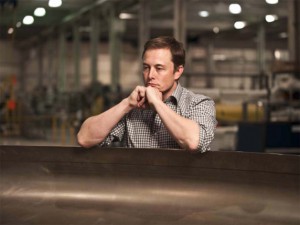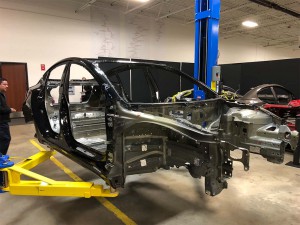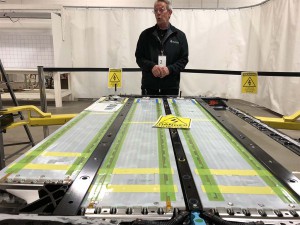With apologies to Charles Dickens, think of it as two tales of a car, suggests Sandy Munro, head of the suburban Detroit competitive analysis firm, Munro and Associates. How can such a breakthrough vehicle also have so many problems, he asks, during a lengthy look at what’s under the skin of the Tesla Model 3.
Over the years, Munro’s firm has vivisected hundreds of automobiles, including a number of new battery-electric vehicles, such as the BMW i3 and Chevrolet Bolt EV. But few teardowns, he suggested, have been more eye-opening than Tesla’s first mainstream offering. In terms of its battery-based drivetrain technology, the Model 3 readily sets a benchmark, but it’s another matter entirely with many of the things an owner more readily sees, including a body with massive quality and fit-and-finish problems.
“It’s the best of (cars) and the worst of (cars),” Munro said, during a special meeting of the Detroit Automotive Press Association held at his Auburn Hills facility. “Some stuff gets a six, on a scale of one to five, others a one.”
The Tesla Model 3 officially went into production in July 2017, but it has been a major headache for the California carmaker ever since. Even before it debuted, CEO Elon Musk warned of facing “production hell” at his company’s Fremont, California assembly line. If anything, that may have been an understatement. Problems in Fremont, as well as Tesla’s Gigafactory in Reno, Nevada, have left it running at a fraction of the promised line rate and running up massive losses.
(Tesla ready to go round the clock to boost Model 3 production. Click Here for the latest.)
There have been numerous reports of quality problems forcing extensive rework as cars roll off the line. And Musk earlier this month lamented his initial belief that a heavy investment in robotics would pay off handsomely.
“Yes, excessive automation at Tesla was a mistake,” Musk tweeted. “To be precise, my mistake. Humans are underrated.”
That’s something that the teardown of Munro’s Model 3 quickly reveals.
Considering the shortage of the sedans, which means many potential customer will have to wait until 2019 – and possibly beyond – to get one, Munro had to go to great lengths to purchase a Model 3. His company had to pay $72,000 to buy one from an early customer who ran into financial troubles, or nearly twice what the list price was.
As with any other vehicle it examines, Munro and Associates tears it down, piece by piece, hoping to get a look at virtually every different part and component. It’s looking for the suppliers, the manufacturing techniques, the production costs. “We work on everything,” he explained, down to examining individual rivets and welds.
During a lengthy morning briefing, Munro and his senior team revealed some of the findings. On the plus side, they repeatedly praised the design of the battery system on their Model 3, which was equipped with the extended-range 75 kilowatt-hour pack.
“Tesla fooled everyone in the battery world,” said Mark Ellis, a specialist in battery technology. Dissecting the pack itself, which wasdesigned with the help of Tesla’s battery partner Panasonic, revealed a number of significant breakthroughs in terms of size, cost and energy density. And the design appears to be significantly robust to minimize any possible failures, especially among the 4,416 individual lithium-ion battery cells in the four-module pack.
On the downside, Tesla sealed the system so tightly that it would be virtually impossible to make repairs, requiring a complete pack replacement if there’s a problem. That also would likely limit the ability to later reuse parts of the pack for stationary applications, while making recycling a serious challenge.
According to Munro, everything under the “skateboard,” the Model 3’s underlying platform, is “brilliant,” and stands up as state-of-the-art technology and engineering.
And there are a number of other impressive details in other parts of the vehicle. The climate control system borrows from technology found in the grocery store, rather than in a typical vehicle, to help distribute warming or cooling air without traditional vents. Even the sedan’s floor mats use an unusual method to avoid sliding around without being physical attached.
(Temporary Model 3 production halt raises worries about Tesla. Click Here for the story.)
But that reveals the great irony of the Model 3: when it comes to the things traditional manufacturers have spent decades learning to build properly, Tesla seems to be starting from scratch. Take the way the body panels are bolted together, said Munro, cautioning that, “You can see the gaps from the moon.”
A close inspection of the so-called “Body in White,” the basic frame of the vehicle, minus doors, fenders, hood and trunk, is shocking in terms of its hodgepodge of manufacturing processes – and fastening techniques. In some places, it almost defies logic, according to the Munro team. There are nine pieces where one should be needed for the cargo well, and it reveals rivets punched through from both sides. Oddly, inaccurate human welds are used by the door frames, where robots would do a much more precise and consistent job.
“All the stuff that’s a problem is what I call dinosaur technology,” that virtually all manufacturers long ago learned how to get right,” said Munro. But, in many cases, it’s also the sort of stuff an owner will see, and which could cause squeaks and rattles and quality problems.
“It’s easy to fix,” Munro began, before correcting himself by saying the problems would be if Tesla had designed the body right in the first place, but it could be a major — and costly – headache now, among other things requiring extensive tooling changes.

Tesla CEO Elon Musk has taken to sleeping at the Fremont plant hoping to drive improvements in quality and production levels.
While already broken down into a thousand pieces, the Munro team is continuing to further dissect its Model 3. It has yet to fully calculate what Tesla is paying for all those parts, and for the assembly process.
Meanwhile, another Model 3 has been rolled into the autopsy room and is already beginning to undergo a first-level inspection. Tesla has promised to address its fit-and-finish issues, but Munro noted that there are still “a lot of anomalies.” While better than the first Model 3, the second car still doesn’t appear to live up to global benchmarks in many ways.
(Click Here to find out why Tesla has been hit with an NLRB complaint over last year’s mass firings.)
Tesla CEO Musk recently tweeted a prediction that Model 3 production will nearly triple by the end of the second quarter, to around 6,000 vehicles a week. The company desperately needs to start building and selling more cars if it hopes to start making money after years of heavy losses.
Clearly, the underlying electric drivetrain system should please future buyers. But the company will have to address some serious problems, as well, especially the Model 3’s poor fit-and-finish. It’s those quality and reliability issues that future buyers will see and feel every day, and as Tesla reaches out to more conventional buyers, rather than its early acolytes, that could prove a major challenge to continuing its sales growth.
On the other hand, if Tesla can fix those problems, it could leave the rest of the industry struggling to catch up. And with competitors ready to launch a wave of their own long-range EVs, that could determine whether Tesla lives or dies.





Old news.
We picked our model 3 last week, and fit and finish is top notch.
If Tesla ever actually lets us get close to a production Model 3 we’ll report back.
If the Model 3 is so bad why did the evaluating company have problems obtaining a car? So called ‘lemons’ are easy to buy.
Recall Tesla was originally going to produce almost 100,000 Model 3s in 2018 and boost that to 400,000 this year. Even then, it would have been late in 2018 before the original, advanced reservation list was satisfied. As it stands, production barely got to 2,000 a week by the end of Q1, about 20% below the latest downgraded forecast. There were somewhere north of 400,000 advance reservations, according to Tesla. Even if they DO, finally hit a target — supposedly 6,000/week by end of Q2, production will be well short of original plans and leave many on the list until well into 2019…and even then if many original wannabe customers abandon their reservations. So, I was actually impressed that Munro got a vehicle that quickly. Oh, and read the story carefully; the tear-down reveals a vehicle with a remarkable electric drivetrain but a miserably constructed body. I expect that many — likely the vast majority of — original reservation holders will be willing to put up with poor fit and finish and other issues as long as the battery drive system doesn’t start failing.
Paul E.